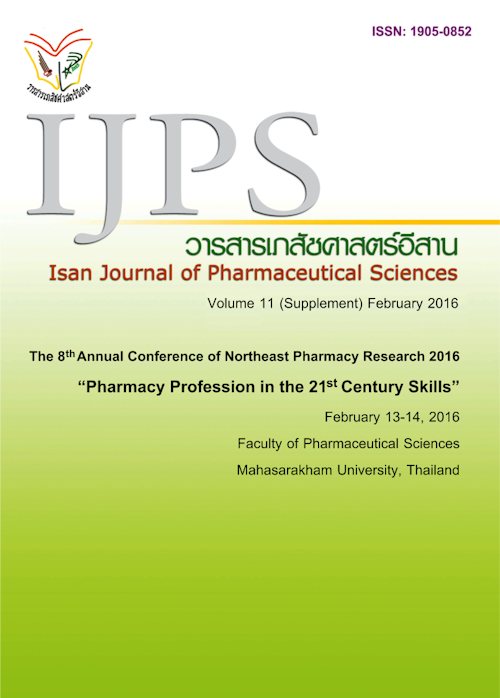Development of Niosome as a Drug Delivery System of Kaempferia parviflora Extract
Main Article Content
Abstract
Introduction: Kaempferia parviflora (KP) showed various pharmacological effects such as antiinflammation,
anti-oxidation, and antimicrobial activities. Its major contents include several methoxyflavones
which posses many pharmacological effects. However, the methoxyflavones are known to be hydrophobic
property and has low absorption, which limits the utilization of KP. This study was to investigate the feasibility
of using niosome as a drug delivery system for KP extracts. Methods: Niosomes were prepared by thin film
hydration method (using different surfactants including Span®60, Span®80, and Tween®80). The formulations
composed of 1:1:0.1 mass ratio of non-ionic surfactant: cholesterol: KP extract as the vesicle forming agents.
Furthermore, we also studied the effect of stabilizer (dihexadecyl phosphate) on niosomes properties.
Results: The results showed particle sizes of the developed niosomes between 0.164-2.919 μm. Span®80-
Niosome possessed significantly the lowest size as compared to the other formulations (0.164 μm, PDI
0 . 5 03). We successfully entrapped the methoxyflavones in all formulations with entrapment efficiencies
between 70-99%. Among the tested formulations, Span®60-Niosome significantly possessed the highest
entrapment efficiency (97.7-98.4%). For stability study by using heat-cool cycling method, the entrapment
efficiency of Span®60-Niosome and Tween®80-Niosome significantly decreased but their entrapment
percentage remained high (85-91%) whereas the entrapment efficiency of Span®80-Niosome significantly
increased (95.4-97.2%). The effect of dihexadecyl phosphate on its stability showed that the particle sizes of
Span®60-Niosome and Span®80-Niosome significantly increased and its percentage of entrapment
significantly reduced. Nevertheless, Tween®80-niosome with dihexadecyl phosphate showed that its particle
size was significantly decreased and the percentage of entrapment was significantly increased after keep in
heat-cool cycling. However, Tween®80-Niosome contained a lot of bubbles during formulation and it showed
phase separation after heat-cool cycling. Conclusion: Therefore, Span®60 was proper to be a non-ionic
surfactant to formulate the niosome formulation as a novel drug delivery system of KP extract.
Article Details
In the case that some parts are used by others The author must Confirm that obtaining permission to use some of the original authors. And must attach evidence That the permission has been included
References
Abdelbary G, El-gendy N. Niosome-encapsulated gentamicin for ophthalmic controlled delivery. Pharm SciTech 2008; 9: 740-747.
Akase T, Shimada T, Terabayashi S, et al. Antiobesity effects of Kaempferia parviflora in spontaneously obese type II diabetic mice. J Nat Med 2011; 65: 73–80.
Chaturapanich G, Chaiyakul S, Verawatnapakul V, et al. Effects of Kaempferia parviflora extracts on reproductive parameters and spermatic blood flow in male rats. Reproduction 2008; 136: 515–522.
Daodee S. Products of Kaempferia parviflora. In:Sripanidkulchai B, editors. Kaempferiaparviflora: Research and development. Khon Kaen: Klungnanavittaya printing; 2010. 333.[in Thai]
Griffin W.C. Classification of surface active agents by HLB. J Soc Cosmet Chem 1949; 1: 311-326.
Hanu P, Harmanpreet S. Formulation and evaluation of niosome containing punicalagin form peels of Punicagranatum. J Drug Deliv Therapeutics 2012; 2(6): 56-67.
Jiranaikulwanitch J, Teeraniti N. Preparation of mango leaf extract niosomes. A special project submitted in partial fulfilent of the requirement for the Bachelor degree of science in pharmacy 2005. [in Thai]
Kato K, Walde P, Koine N, et al. Temperaturesensitive nonionic vesicles prepared from Span® 80 (Sorbitan Monooleate). Langmuir 2008; 24: 10762-10770.
Kummee S, Tewtrakul S, Subhadhirasakul S. Antimicrobial activity of the ethanol extract and compounds from the rhizomes of Kaempferia parviflora. Songklanakarin J Sci Technol 2008; 30(4): 463-466.
Malakul W, Ingkaninan K, Sawasdee P, et al. The ethanolic extract of Kaempferia parviflora reduces ischaemic injury in rat isolated hearts. J Ethnopharmacol 2011; 137: 184-191.
Mekjaruskul C, Yang YT, Leed MGD, et al. Novel formulation strategies for enhancing oral delivery of methoxyflavones in Kaempferia parviflora by SMEDDS or complexation with 2-hydroxypropyl-β-cyclodextrin. Int J Pharm. 2013; 445:1–11.
Ramrit T, Yingngam B, Rungseevijitprapa W. Development of Tripala niosomes. IJPS 2014; 9: 22-26. [in Thai]
Rujjanawate C, Kanjanapothi D, Amornlerdpison D, et al. Anti-gastric ulcer effect of Kaempferia parviflora. J Ethnopharmacol 2005; 102: 120–122.
Sae-wong C, Tansakul P, Tewtrakul S. Antiinflammatory mechanism of Kaempferia parviflora in murine macrophage cells (RAW264.7) and in experimental animals. J Ethnopharmacol 2009; 124: 576–80.
Sripanidkulchai B. Botanical characteristics of Kaempferia parviflora. In: Sripanidkulchai B, editors. Kaempferiaparviflora: Research and development. Khon Kaen: Klungnanavittaya printing; 2010. 47-48. [in Thai]
Sutthanut K, Sripanidkulchai B, Yenjai C, et al. Simultaneous identification and quantitation of 11 flavonoid constituents in Kaempferia parviflora by gas chromatography. J Chromatogr A 2007; 1143 (1-2): 227–233.
Tewtrakul S, Subhadhirasakul S, Kummee S. Antiallergic activity of compounds from Kaempferia parviflora. J Ethnopharmacol 2008; 116: 191–193.
Thanaketpaisarn O. Niosome delivery systems in pharmaceutical applications. IJPS 2012; 8(2): 12-26. [in Thai]
Waddad AY, Abbad S, Yu F, et al. Formulation characterization and pharmacokinetics of Morin hydrate niosomes prepared from various non-ionic surfactants. Int J Pharm. 2013; 456: 446-456.
Yenjai C, Prasanphen K, Daodee S, et al.
Bioactive flavonoids from Kaempferiaparviflora. Fitoterpia 2004; 75(1): 89-92.
Yoshioka T, Sternberg B, Florence AT. Preparation and properties of vesicles (Niosomes) of sorbitan monoesters (Span-20, Span-40, Span-60 and Span-80) and a Sorbitan Triester (Span-85). Int J Pharm 1994; 105:1-6.


